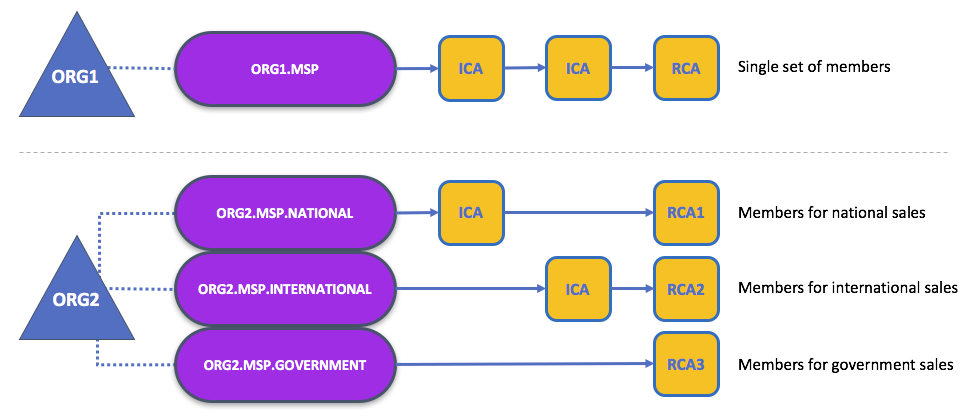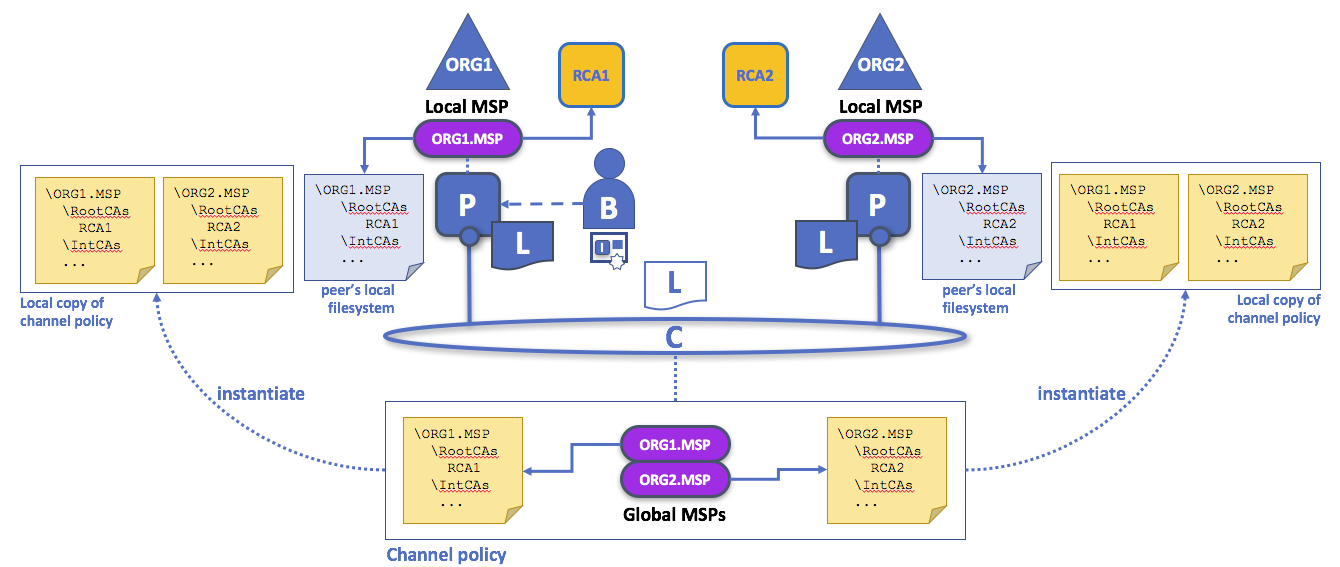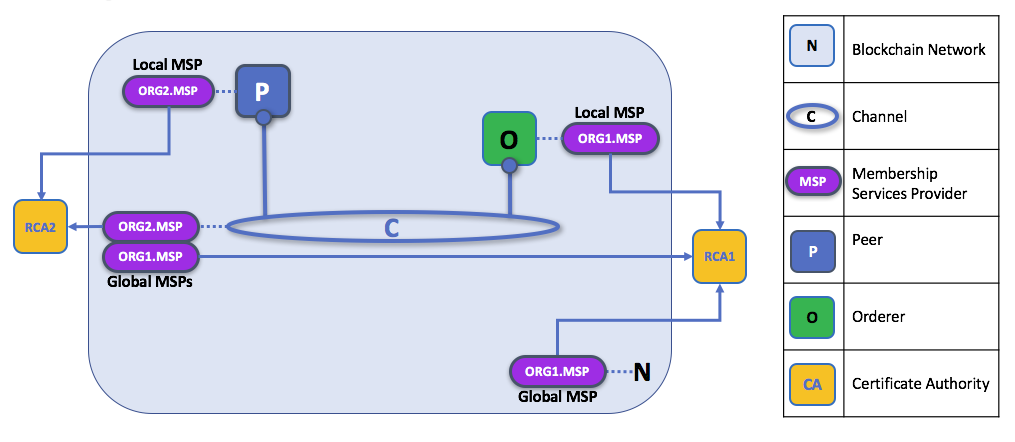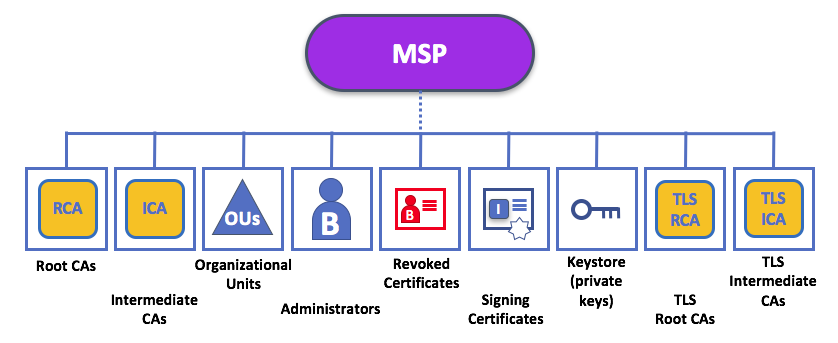Membership¶
If you’ve read through the documentation on identity you’ve seen how a PKI can provide verifiable identities through a chain of trust. Now let’s see how these identities can be used to represent the trusted members of a blockchain network.
This is where a Membership Service Provider (MSP) comes into play — it identifies which Root CAs and Intermediate CAs are trusted to define the members of a trust domain, e.g., an organization, either by listing the identities of their members, or by identifying which CAs are authorized to issue valid identities for their members, or — as will usually be the case — through a combination of both.
The power of an MSP goes beyond simply listing who is a network participant or member of a channel. An MSP can identify specific roles an actor might play either within the scope of the organization the MSP represents (e.g., admins, or as members of a sub-organization group), and sets the basis for defining access privileges in the context of a network and channel (e.g., channel admins, readers, writers).
The configuration of an MSP is advertised to all the channels where members of the corresponding organization participate (in the form of a channel MSP). In addition to the channel MSP, peers, orderers, and clients also maintain a local MSP to authenticate member messages outside the context of a channel and to define the permissions over a particular component (who has the ability to install chaincode on a peer, for example).
In addition, an MSP can allow for the identification of a list of identities that have been revoked — as discussed in the Identity documentation — but we will talk about how that process also extends to an MSP.
We’ll talk more about local and channel MSPs in a moment. For now let’s see what MSPs do in general.
Mapping MSPs to Organizations¶
An organization is a managed group of members. This can be something as big as a multinational corporation or a small as a flower shop. Typically an organization is represented as a single MSP. Note that this is different from the organization concept defined in an X.509 certificate, which we’ll talk about later.
The exclusive relationship between an organization and its MSP makes it sensible to
name the MSP after the organization, a convention you’ll find adopted in most policy
configurations. For example, organization ORG1 would likely have an MSP called
something like ORG1-MSP. In some cases an organization may require multiple
membership groups — for example, where channels are used to perform very different
business functions between organizations. In these cases it makes sense to have
multiple MSPs and name them accordingly, e.g., ORG2-MSP-NATIONAL and
ORG2-MSP-GOVERNMENT, reflecting the different membership roots of trust within
ORG2 in the NATIONAL sales channel compared to the GOVERNMENT regulatory
channel.

Two different MSP configurations for an organization. The first configuration shows the typical relationship between an MSP and an organization — a single MSP defines the list of members of an organization. In the second configuration, different MSPs are used to represent different organizational groups with national, international, and governmental affiliation.
Organizational Units and MSPs¶
An organization is often divided up into multiple organizational units (OUs), each
of which has a certain set of responsibilities. For example, the ORG1
organization might have both ORG1-MANUFACTURING and ORG1-DISTRIBUTION OUs
to reflect these separate lines of business. When a CA issues X.509 certificates,
the OU field in the certificate specifies the line of business to which the
identity belongs.
We’ll see later how OUs can be helpful to control the parts of an organization who
are considered to be the members of a blockchain network. For example, only
identities from the ORG1-MANUFACTURING OU might be able to access a channel,
whereas ORG1-DISTRIBUTION cannot.
Finally, though this is a slight misuse of OUs, they can sometimes be used by
different organizations in a consortium to distinguish each other. In such cases, the
different organizations use the same Root CAs and Intermediate CAs for their chain
of trust, but assign the OU field to identify members of each organization.
We’ll also see how to configure MSPs to achieve this later.
Local and Channel MSPs¶
MSPs appear in two types of places in a blockchain network:
- In channel configuration (channel MSP)
- Locally on an actor’s node (local MSP)
Local MSPs are defined for clients (users) and for nodes (peers and orderers). Local MSPs define the permissions for that node (who the peer admins are, for example). The local MSPs of the users allow the user side to authenticate itself in its transactions as a member of a channel (e.g. in chaincode transactions), or as the owner of a specific role into the system (an org admin, for example, in configuration transactions).
Every node and user must have a local MSP defined, as it defines who has administrative or participatory rights at that level (peer admins will not necessarily be channel admins, and vice versa).
In contrast, channel MSPs define administrative and participatory rights at the channel level. Every organization participating in a channel must have an MSP defined for it. Peers and orderers on a channel will all share the same view of channel MSPs, and will therefore be able to correctly authenticate the channel participants. This means that if an organization wishes to join the channel, an MSP incorporating the chain of trust for the organization’s members would need to be included in the channel configuration. Otherwise transactions originating from this organization’s identities will be rejected.
The key difference here between local and channel MSPs is not how they function — both turn identities into roles — but their scope.

Local and channel MSPs. The trust domain (e.g., the organization) of each peer is defined by the peer’s local MSP, e.g., ORG1 or ORG2. Representation of an organization on a channel is achieved by adding the organization’s MSP to the channel configuration. For example, the channel of this figure is managed by both ORG1 and ORG2. Similar principles apply for the network, orderers, and users, but these are not shown here for simplicity.
You may find it helpful to see how local and channel MSPs are used by seeing what happens when a blockchain administrator installs and instantiates a smart contract, as shown in the diagram above.
An administrator B connects to the peer with an identity issued by RCA1
and stored in their local MSP. When B tries to install a smart contract on
the peer, the peer checks its local MSP, ORG1-MSP, to verify that the identity
of B is indeed a member of ORG1. A successful verification will allow the
install command to complete successfully. Subsequently, B wishes
to instantiate the smart contract on the channel. Because this is a channel
operation, all organizations on the channel must agree to it. Therefore, the
peer must check the MSPs of the channel before it can successfully commit this
command. (Other things must happen too, but concentrate on the above for now.)
Local MSPs are only defined on the file system of the node or user to which they apply. Therefore, physically and logically there is only one local MSP per node or user. However, as channel MSPs are available to all nodes in the channel, they are logically defined once in the channel configuration. However, a channel MSP is also instantiated on the file system of every node in the channel and kept synchronized via consensus. So while there is a copy of each channel MSP on the local file system of every node, logically a channel MSP resides on and is maintained by the channel or the network.
MSP Levels¶
The split between channel and local MSPs reflects the needs of organizations to administer their local resources, such as a peer or orderer nodes, and their channel resources, such as ledgers, smart contracts, and consortia, which operate at the channel or network level. It’s helpful to think of these MSPs as being at different levels, with MSPs at a higher level relating to network administration concerns while MSPs at a lower level handle identity for the administration of private resources. MSPs are mandatory at every level of administration — they must be defined for the network, channel, peer, orderer, and users.

MSP Levels. The MSPs for the peer and orderer are local, whereas the MSPs for a channel (including the network configuration channel) are shared across all participants of that channel. In this figure, the network configuration channel is administered by ORG1, but another application channel can be managed by ORG1 and ORG2. The peer is a member of and managed by ORG2, whereas ORG1 manages the orderer of the figure. ORG1 trusts identities from RCA1, whereas ORG2 trusts identities from RCA2. Note that these are administration identities, reflecting who can administer these components. So while ORG1 administers the network, ORG2.MSP does exist in the network definition.
- Network MSP: The configuration of a network defines who are the members in the network — by defining the MSPs of the participant organizations — as well as which of these members are authorized to perform administrative tasks (e.g., creating a channel).
- Channel MSP: It is important for a channel to maintain the MSPs of its members
separately. A channel provides private communications between a particular set of
organizations which in turn have administrative control over it. Channel policies
interpreted in the context of that channel’s MSPs define who has ability to
participate in certain action on the channel, e.g., adding organizations, or
instantiating chaincodes. Note that there is no necessary relationship between
the permission to administrate a channel and the ability to administrate the
network configuration channel (or any other channel). Administrative rights
exist within the scope of what is being administrated (unless the rules have
been written otherwise — see the discussion of the
ROLEattribute below). - Peer MSP: This local MSP is defined on the file system of each peer and there is a single MSP instance for each peer. Conceptually, it performs exactly the same function as channel MSPs with the restriction that it only applies to the peer where it is defined. An example of an action whose authorization is evaluated using the peer’s local MSP is the installation of a chaincode on the peer.
- Orderer MSP: Like a peer MSP, an orderer local MSP is also defined on the file system of the node and only applies to that node. Like peer nodes, orderers are also owned by a single organization and therefore have a single MSP to list the actors or nodes it trusts.
MSP Structure¶
So far, you’ve seen that the most important element of an MSP are the specification of the root or intermediate CAs that are used to establish an actor’s or node’s membership in the respective organization. There are, however, more elements that are used in conjunction with these two to assist with membership functions.

The figure above shows how a local MSP is stored on a local filesystem. Even though channel MSPs are not physically structured in exactly this way, it’s still a helpful way to think about them.
As you can see, there are nine elements to an MSP. It’s easiest to think of these elements in a directory structure, where the MSP name is the root folder name with each subfolder representing different elements of an MSP configuration.
Let’s describe these folders in a little more detail and see why they are important.
Root CAs: This folder contains a list of self-signed X.509 certificates of the Root CAs trusted by the organization represented by this MSP. There must be at least one Root CA X.509 certificate in this MSP folder.
This is the most important folder because it identifies the CAs from which all other certificates must be derived to be considered members of the corresponding organization.
Intermediate CAs: This folder contains a list of X.509 certificates of the Intermediate CAs trusted by this organization. Each certificate must be signed by one of the Root CAs in the MSP or by an Intermediate CA whose issuing CA chain ultimately leads back to a trusted Root CA.
An intermediate CA may represent a different subdivision of the organization (like
ORG1-MANUFACTURINGandORG1-DISTRIBUTIONdo forORG1), or the organization itself (as may be the case if a commercial CA is leveraged for the organization’s identity management). In the latter case intermediate CAs can be used to represent organization subdivisions. Here you may find more information on best practices for MSP configuration. Notice, that it is possible to have a functioning network that does not have an Intermediate CA, in which case this folder would be empty.Like the Root CA folder, this folder defines the CAs from which certificates must be issued to be considered members of the organization.
Organizational Units (OUs): These are listed in the
$FABRIC_CFG_PATH/msp/config.yamlfile and contain a list of organizational units, whose members are considered to be part of the organization represented by this MSP. This is particularly useful when you want to restrict the members of an organization to the ones holding an identity (signed by one of MSP designated CAs) with a specific OU in it.Specifying OUs is optional. If no OUs are listed, all the identities that are part of an MSP — as identified by the Root CA and Intermediate CA folders — will be considered members of the organization.
Administrators: This folder contains a list of identities that define the actors who have the role of administrators for this organization. For the standard MSP type, there should be one or more X.509 certificates in this list.
It’s worth noting that just because an actor has the role of an administrator it doesn’t mean that they can administer particular resources! The actual power a given identity has with respect to administering the system is determined by the policies that manage system resources. For example, a channel policy might specify that
ORG1-MANUFACTURINGadministrators have the rights to add new organizations to the channel, whereas theORG1-DISTRIBUTIONadministrators have no such rights.Even though an X.509 certificate has a
ROLEattribute (specifying, for example, that an actor is anadmin), this refers to an actor’s role within its organization rather than on the blockchain network. This is similar to the purpose of theOUattribute, which — if it has been defined — refers to an actor’s place in the organization.The
ROLEattribute can be used to confer administrative rights at the channel level if the policy for that channel has been written to allow any administrator from an organization (or certain organizations) permission to perform certain channel functions (such as instantiating chaincode). In this way, an organizational role can confer a network role.
Revoked Certificates: If the identity of an actor has been revoked, identifying information about the identity — not the identity itself — is held in this folder. For X.509-based identities, these identifiers are pairs of strings known as Subject Key Identifier (SKI) and Authority Access Identifier (AKI), and are checked whenever the X.509 certificate is being used to make sure the certificate has not been revoked.
This list is conceptually the same as a CA’s Certificate Revocation List (CRL), but it also relates to revocation of membership from the organization. As a result, the administrator of an MSP, local or channel, can quickly revoke an actor or node from an organization by advertising the updated CRL of the CA the revoked certificate as issued by. This “list of lists” is optional. It will only become populated as certificates are revoked.
Node Identity: This folder contains the identity of the node, i.e., cryptographic material that — in combination to the content of
KeyStore— would allow the node to authenticate itself in the messages that is sends to other participants of its channels and network. For X.509 based identities, this folder contains an X.509 certificate. This is the certificate a peer places in a transaction proposal response, for example, to indicate that the peer has endorsed it — which can subsequently be checked against the resulting transaction’s endorsement policy at validation time.This folder is mandatory for local MSPs, and there must be exactly one X.509 certificate for the node. It is not used for channel MSPs.
KeyStorefor Private Key: This folder is defined for the local MSP of a peer or orderer node (or in an client’s local MSP), and contains the node’s signing key. This key matches cryptographically the node’s identity included in Node Identity folder and is used to sign data — for example to sign a transaction proposal response, as part of the endorsement phase.This folder is mandatory for local MSPs, and must contain exactly one private key. Obviously, access to this folder must be limited only to the identities of users who have administrative responsibility on the peer.
Configuration of a channel MSPs does not include this folder, as channel MSPs solely aim to offer identity validation functionalities and not signing abilities.
TLS Root CA: This folder contains a list of self-signed X.509 certificates of the Root CAs trusted by this organization for TLS communications. An example of a TLS communication would be when a peer needs to connect to an orderer so that it can receive ledger updates.
MSP TLS information relates to the nodes inside the network — the peers and the orderers, in other words, rather than the applications and administrations that consume the network.
There must be at least one TLS Root CA X.509 certificate in this folder.
TLS Intermediate CA: This folder contains a list intermediate CA certificates CAs trusted by the organization represented by this MSP for TLS communications. This folder is specifically useful when commercial CAs are used for TLS certificates of an organization. Similar to membership intermediate CAs, specifying intermediate TLS CAs is optional.
For more information about TLS, click here.
If you’ve read this doc as well as our doc on Identity), you should have a pretty good grasp of how identities and membership work in Hyperledger Fabric. You’ve seen how a PKI and MSPs are used to identify the actors collaborating in a blockchain network. You’ve learned how certificates, public/private keys, and roots of trust work, in addition to how MSPs are physically and logically structured.